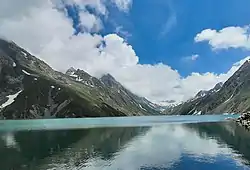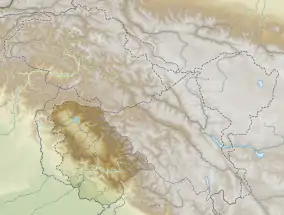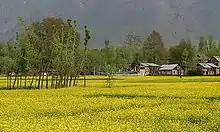Kausar Nag
Kausar Nag or Kausarnag (sometimes alternatively spelled as Konsarnag), is a high-altitude oligotrophic lake located at an elevation of 3,962.4 metres (13,000 ft) above sea level.[1] Kausar Nag is located in the Pir Panjal Range in district Kulgam of Jammu and Kashmir.The lake is roughly 2 miles long and half a mile at the widest point.[2]
| Kausar Nag | |
|---|---|
 Kausar Nag Lake In August. | |
 Kausar Nag Location in Jammu and Kashmir, India  Kausar Nag Kausar Nag (India) | |
| Location | Kulgam, Kashmir valley, India |
| Coordinates | 33°30′44″N 74°46′08″E |
| Type | Oligotrophic lake |
| Primary inflows | Melting of snow |
| Primary outflows | A tributary of Aharbal waterfall |
| Max. length | 3 kilometres (1.9 mi) |
| Max. width | 0.9 kilometres (0.56 mi) |
| Surface elevation | 3,962.4 metres (13,000 ft) |
| Frozen | November to July |

The famous lake of Kousarnag is situated in the Pir Panjal range in district Kulgam of Jammu and Kashmir. The lake is oligotropic and is located amid three lofty peaks. The length of the lake is approximately 3km and it is half a mile in width. The water is ice cold and crystal clear. However, like springs the water is bit warmer than other surrounding glacial streams and you can take few dips in it. The peaks surrounding the lake are snow capped almost round the year. From November to June, the lake remains frozen. In July and August the snow melts and the water of Kousarnag begins to gently lap on the shores.
The lake is the chief source of river Veshaw River, which is an important tributary of Jhelum River. The lake is bestowed with some important medicinal plants as well, among them koth, dhoop, pamsalan. Kousarnag is considered as a sacred spot and many people visit here as part of their faith. Also, Gujjar and Bakerwal people rear sheep in the pastures lying below the lake during summer months. They reside in rocky caves during this season.
The trekking path to Kousarnag is enchanting. However, unlike tosamaidan trail, the track here is rocky. The more common way to the lake is from Aharbal. Another way is from Nadibal but this route is lengthier. From Aharbal to Kungwatan is 9 km, while from Kungwatan to Mahinag is 7 km, and finally from Mahinag to Kousarnag is approximately again 7 km. Below Kousarnag is a wide valley called Nekisar or Neelam Valley, one of finest designs of nature.
The Nadibal route starts from villages KB Pora and Avil. One can set off the trekking from either of the two villages to reach Nadibal, just 3 km from these twin villages. From Nadibal is a rocky terrain that leads to Telgogul Pathri, which further reaches to Alismud. From Alismud the route to the lake passes through dense and lush green forests from Cheran Bal to Sunderbouk, which again connects to Manzipal and then to Lehan Patri. It takes almost 4 hours to reach Lehan Patri. From Lehan Patri the way again passes through serene beautiful spots like Kachoie, Kholi Galli, and intersects at the route to Aharbal at Kong Watan. From here, the two ways merge and lead to Kousarnag.
The bridges connecting different spots like Cheranbal, Lawayward, and Kachoie are simple wooden blocks which are unsafe to cross and pose a serious threat to the nomadic people who migrate for rearing cattle in summer season. Also, these bridges are usually washed away during heavy rainfall and floods, thus making the life of nomadic people like Gujjars, Bakerwals and Chopans miserable. These nomadic people usually migrate along with their schoolgoing children from May to end September. The government used to establish temporary seasonal schools to cater to the educational needs of their children at different pastures/ Behaks. Unfortunately, these seasonal schools have not been established since the last three years. The government of J&K needs to revive the earlier mechanism for imparting education to the vulnerable lot, otherwise it will increase the dropout rate in schools.
Besides, massive deforestation and burning of stems of pine trees for charcoal has turned many lush green forests into deserts, especially at Lehan Pathri and Manzipal. The forest department needs to curb the menace of burning and debarking of pine trees, or the forests will be permanently destroyed.
Trekking to Kousarnag lake is adventurous and enthralling. The mesmirising beauty of the lake is divine and reinvigorates the spirit that has been dulled by the ebbs and flows of life. The expedition is really enchanting and the panacea of all ills. Although the route to the lake is tough, as one has to traverse through rough edges and rocky surfaces, but the desire to have a glimpse of the lake infuses new energy. The cold breeze provides a soothing touch to the body and the soul gets lost in the fold of nature. In other words, nature embraces the soul of the visitor, attesting to the truth of Keats’ words: “A thing of beauty is a joy for ever.”
Littering is strictly prohibited and keep kausarnag clean.
Gallery

References
- G. M. D. Sufi (2006). Kashīr, being a history of Kashmīr from the earliest times to our own, Volume 1. University of Michigan. p. 44.
- "VAM :: Vertical Amble Mountaineering: Kausar Nag Trek Information". Verticalamble.in. Retrieved 3 August 2014.
